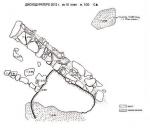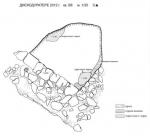Summary (English)
DISCODURATERAE (Ilian Boyanov – ilianboyanov@nbu.bg) A wall was documented in Building 6, 90 cm wide and built of roughly-cut stones bonded with clay. Fragmentary wattle-and-daub was found, indicating the structure of the upper part of the building. The roof was covered with tegulae and imbrices. Coins and pottery of the 4th century AD, slag, two terracotta melting pots and iron objects, indicating metallurgical production, were discovered on the floor. A wall of roughly-cut stones bonded with clay, 50 cm wide, was explored in Building 7. Fragmentary wattle-and-daub, tegulae, imbrices, fibulae and coins of the end of the 4th – beginning of the 5th centuries AD were discovered. Building 8 was situated under Building 7. Its structure was of roughly-cut stones bonded with clay. Tegulae, imbrices, fragmentary wattle-and-daub and coins of the 4th century AD were found. The western corner circular fortification tower was not connected to the structure of the fortification wall. The corner towers probably were additionally built. The fortification wall was preserved up to 1.43 m in height. A burial of a young woman of the 13th – 14th century was explored in Sector IV, Trench H5. Five occupation periods were documented. The first one was from AD 175 – 200 to the Gothic invasion in AD 250 – 251. A Roman provincial bronze coin of Caracalla minted in Serdica was found. The Gothic invasion was documented with a layer with traces from fire, containing a coin of Gordian III and a fibula of the mid 3rd century AD. The second period was documented with coins from Claudius II Gothicus to Diocletian and sherds from terra sigillata. The fortification wall was built in that period, as evidenced by the inscription devoted to Philip the Arab, incorporated into the fortification gate. The third period was documented with coins from Constantine the Great to Constantius II. The fourth period was documented with coins of Theodosius I, Arcadius and Honorius. The invasion of the Huns in AD 443 – 447 might have been the reason for the end of Discoduraterae. The fifth period is related to the Mediaeval settlement of the 13th – 14th centuries.
- Ilian Boyanov - Department of Archaeology, New Bulgarian University
Director
Team
Research Body
- New Bulgarian University






![Download [PDF]](/excavation/skins/fasti/images/results/download_sml.png)
